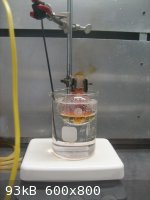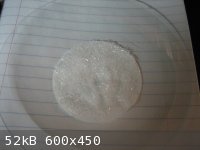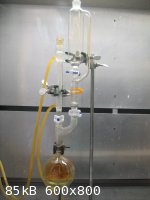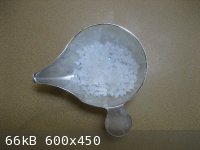| Pages:
1
2 |
Magpie
lab constructor
    
Posts: 5939
Registered: 1-11-2003
Location: USA
Member Is Offline
Mood: Chemistry: the subtle science.
|
|
oxidation of diols
oxidation of ethylene glycol to oxalic acid
HO-CH2CH2-OH + 8HNO3 --> 8NO2 + HOOC-COOH + 6H2O
Preliminary
Yesterday I recovered about 75 mL of ethylene glycol from antifreeze by fractional distillation. Column packing was a ss scrub pad. This antifreeze
contained, besides EG, diethylene glycol, water, dipotassium phosphate, corrosion inhibiters, defoamer, silicates, and dye.
The distillation went very well with a little water coming off first right at 100C, then the EG came off cleanly at 196-197C. I started with 125 mL
and left about 25 mL in the pot. It's not like I have any shortage of antifreeze.
Oxalic Acid Procedure
The following procedure is based on "Oxidation with Nitric Acid of Aliphatic Alcohols and Diols to Carboxylic Acids" from the Russian Journal of
Organic Chemistry, 2006. My thanks to forum member sonogashira for this paper.
Today 5.6 mL (0.1 mole) of EG was placed in a beaker and 33 mL (0.5 mole) of 68% nitric acid (the azeotrope) was added and stirred. Temperature only
rose to 30C from room temperature. This was then placed in a 100 mL RBF suspended in a silicone oil bath under temperature control at 88C. For some
minutes nothing was happening although I could see a little brown coloration, indicating production of NO2. My PID controller wasn't properly tuned
and the temperature rose to 97C. Still no action. Then, all of a sudden there was a runaway with copious amounts of NO2 generated. I quickly turned
on the hood fan which immediately vacated the brown fumes filling the hood space.
Things did settle down without any boilover. The reactants were kept stirred in the bath for a total of 4.5 hours.
The products were set aside to cool to room temperature whereupon crystals (needles) of putative oxalic acid formed. These were Buchner funnel dried
with no wash. After air drying 2.3g of crystals were obtained for a yield of 25%, assuming the crystals are not hydrated.
Discussion
This synthesis was done only to determine the viability of the Russian procedure for making dicarboxylic acids from diols. The expected yield was
69%, so that is a little disappointing. But there was no char, and I did use 68% nitric acid vs the prescribed 80% nitric acid. There may be better
procedures for making dicarboxylic acids but the viability of this one is established for me. The workup is extremely simple.

[Edited on 19-9-2009 by Magpie]

[Edited on 19-9-2009 by Magpie]
[Edited on 19-9-2009 by Magpie]
The single most important condition for a successful synthesis is good mixing - Nicodem
|
|
|
not_important
International Hazard
    
Posts: 3873
Registered: 21-7-2006
Member Is Offline
Mood: No Mood
|
|
Have you considered the "nickle peroxide" oxidation using a nickle salt with NaOCl? It might not work well with ethylene glycol/oxalic acid, but for
longer terminal diols I think it would be viable. The workup might be a little more complex, depending on the water solubility of the acid and its
sodium salt, but still shouldn't be too bad.
As for your experiment, indeed you may have lost some oxalic acid by solution in the more dilute HNO3. Isolating the product as calcium oxalate might
have been a better indicator of yield.
|
|
|
Magpie
lab constructor
    
Posts: 5939
Registered: 1-11-2003
Location: USA
Member Is Offline
Mood: Chemistry: the subtle science.
|
|
| Quote: |
Have you considered the "nickle peroxide" oxidation using a nickle salt with NaOCl?
|
No, I've never heard of that method. The only oxidants that I've seen commonly used for oxidation of alcohols are KMnO4, K2Cr2O7/H2SO4, and nitric
acid. Potassium persulfate probably also would work.
The reason I chose nitric acid to begin with is that I found some procedures in Cumming for diols.
Looking harder at my 1st post I see that theoretically the mole ratio of nitric acid to EG is 8:1. But I only charged at 5:1. I just mimicked the
Russian procedure.
[Edited on 19-9-2009 by Magpie]
The single most important condition for a successful synthesis is good mixing - Nicodem
|
|
|
kclo4
National Hazard
   
Posts: 916
Registered: 11-12-2004
Location:
Member Is Offline
Mood: No Mood
|
|
Same reaction, might be of interest: http://www.thevespiary.org/Douchermann/orgysynpages/oxalicac...
|
|
|
not_important
International Hazard
    
Posts: 3873
Registered: 21-7-2006
Member Is Offline
Mood: No Mood
|
|
Well, I can't find the thread it was discussed in, so here's one of the articles attached. Gives a 68% yield of adipic acid from the corresponding
diol. It chops 1,2-diols, opening rings or giving the two acids from the fragmented chain.
Also see this PDF http://www.sciencemadness.org/talk/files.php?pid=93387&a...
for using preformed "nickle peroxide" for similar purposes. It can oxidise benzyl alcohol in benzene to the aldehyde with yields in the 80-90 percent
range. It seems to be a little milder and easier to control/stop than NaOCl+Ni.
There's also some literature on using electrolytic oxidation at nickle oxide electrodes.
Attachment: Nickel-hypochlorite oxidizer.pdf (186kB)
This file has been downloaded 3139 times
|
|
|
behemoth
Harmless

Posts: 17
Registered: 19-8-2009
Member Is Offline
Mood: No Mood
|
|
Quote: Originally posted by Magpie  |
The following procedure is based on "Oxidation with Nitric Acid of Aliphatic Alcohols and Diols to Carboxylic Acids" from the Russian Journal of
Organic Chemistry, 2006. |
I have found it as:
"Oxidation with nitric acid of aliphatic alcohols and diols to carboxylic acids"
Authors: Svetlakov, N.; Nikitin, V.; Nikolaeva, E.
Source: Russian Journal of Organic Chemistry, Volume 43, Number 5, May 2007 , pp. 773-774(2)
Publisher: MAIK Nauka/Interperiodica
Would someone post this reference please?
|
|
|
Magpie
lab constructor
    
Posts: 5939
Registered: 1-11-2003
Location: USA
Member Is Offline
Mood: Chemistry: the subtle science.
|
|
This paper was recently posted in the references thread. If you don't have access to this ask a moderator for same.
The single most important condition for a successful synthesis is good mixing - Nicodem
|
|
|
Rich_Insane
Hazard to Others
  
Posts: 371
Registered: 24-4-2009
Location: Portland, Oregon
Member Is Offline
Mood: alive
|
|
Forgive me if I'm wrong, but wouldn't the use of dichromate via chromic acid work to oxidize diols? As far as I know, alcohols can be oxidized to
carboxylic acids by this method.
|
|
|
Magpie
lab constructor
    
Posts: 5939
Registered: 1-11-2003
Location: USA
Member Is Offline
Mood: Chemistry: the subtle science.
|
|
This has already been mentioned. 
| Quote: |
The only oxidants that I've seen commonly used for oxidation of alcohols are KMnO4, K2Cr2O7/H2SO4, and nitric acid. Potassium persulfate probably also
would work.
|
The single most important condition for a successful synthesis is good mixing - Nicodem
|
|
|
S.C. Wack
bibliomaster
    
Posts: 2419
Registered: 7-5-2004
Location: Cornworld, Central USA
Member Is Offline
Mood: Enhanced
|
|
I'd guess that adding the nitric acid dropwise to hot glycol would be a better procedure than adding all of it and then heating.
Alkaline permanganate works for oxalic acid, but is obviously slightly less simple in the isolation.
|
|
|
entropy51
Gone, but not forgotten
    
Posts: 1612
Registered: 30-5-2009
Member Is Offline
Mood: Fissile
|
|
Magpie, there is a procedure for the HNO3 oxidation of glycol in the June 1939 edition of J Chem Ed, page 285, "Some Improved Procedures for the
Elementary Organic Laboratory" by Keith M. Seymour. The file is attached.
This prep uses 6N HNO3 instead of concentrated and says the diluted acid gives a higher yield. It also says that a runaway is essentially to be
expected. He uses 200g 6N HNO3 for 12.4 g of glycol.
It reports a yield of 55 - 67%, sometimes as high as 80%. I'm fairly certain that your crystals are the hydrate.
[Edited on 19-9-2009 by entropy51]
Attachment: organic lab improvements 1.pdf (172kB)
This file has been downloaded 884 times
|
|
|
Magpie
lab constructor
    
Posts: 5939
Registered: 1-11-2003
Location: USA
Member Is Offline
Mood: Chemistry: the subtle science.
|
|
Thank you entropy, I can likely find that journal at my local library.
I agree that my crystals are probably oxalic acid dihydrate. I'm just too lazy to dry them and determine a mp. That would be the safe thing to do,
however.
It's interesting that they claim 6N HNO3 is best. The Russians make the same claim for 75-80% HNO3. 
Edit: Thanks for the reference link. I didn't know that they did anything serious at Reed College. 
[Edited on 20-9-2009 by Magpie]
[Edited on 20-9-2009 by Magpie]
The single most important condition for a successful synthesis is good mixing - Nicodem
|
|
|
Magpie
lab constructor
    
Posts: 5939
Registered: 1-11-2003
Location: USA
Member Is Offline
Mood: Chemistry: the subtle science.
|
|
Yesterday I began experimentation with the preparation of malonic acid from 1,3-propanediol using nitric acid as oxidant. I mixed 0.2 mole (14.4mL)
of PD with 1 mole of 6N nitric acid (169 mL) in a 500mL RBF with reflux condenser attached. I turned the hood fan on and pulled down the window. I
began gentle heating with a bunsen burner until the reaction took hold. What followed was a viscious runaway, with reactants (hot nitric acid)
spraying out the top of the reflux column. All I could do is duck back around the corner and let it go. What saved me from burns is the hood window.
This is, of course, both embarassing and sobering. I've experience oxidizing alcohols and should have been more cautious. I think the relatively
moderate reaction with ethylene glycol had lulled me into a false sense of security.
S.C. Wack says:
| Quote: |
I'd guess that adding the nitric acid dropwise to hot glycol would be a better procedure than adding all of it and then heating.
|
This is the right approach when doing this type of reaction on an experimental basis. After hosing down everything in the hood with water I prepared
to try it again. This time I would go half scale and add the diol with a pressure equalizing funnel.
I first added 3 drops of diol to the acid before any heating. Then I gently heated until that small amount of diol began reacting. Then removed the
heat and added the diol 5 drops at a time as the reaction subsided. This kept everything under good control. After all the diol was added the RBF
was placed in a silicone oil bath set at 105C and heated for another 1/2 hour.
I can see now why only a 5:1 mole ratio of nitric acid to diol is needed. The nitric is mostly reduced to NO, not NO2. This is most graphically seen
at the top of the reflux column where the clear gas rising in the column is converted to NO2 as it contacts the O2 in the atmosphere. So, this is
probably a more correct stoichiometry:
3HO-(CH2)3-OH + 8HNO3-->3HOOC-CH2-COOH + 8NO + 10H2O
I now have the putative malonic acid products sitting in an evaporating dish. I don't want to go through an ether extraction. For one thing I don't
see how it can be very effective when the solubility of malonic acid in water is 1g/0.65 mL water. I am planning on doing another batch where I will
convert the malonic acid to diethyl malonate. This may be the most effective way to recover the acid itself, also.
Any suggestions for workup of the malonic acid are welcomed.

[Edited on 24-9-2009 by Magpie]
The single most important condition for a successful synthesis is good mixing - Nicodem
|
|
|
not_important
International Hazard
    
Posts: 3873
Registered: 21-7-2006
Member Is Offline
Mood: No Mood
|
|
Note that the Org Syn entry does an ether extraction from a concentrated solution with a lot of CaCl2 in it, and they use a
continuous extractor.
As for workup, unfortunately the best workup seems to be along the lines of the O.S. route. As you've a solution of the free acid, treat the solution
with saturated solution of calcium acetate, filter off the calcium malonate and wash it, then follow O.S. for the free acid.
Alternatively just evaporate the solution under reduced pressure to remove excess HNO3, perhaps redissolve in water and repeat the evaporation.
|
|
|
Magpie
lab constructor
    
Posts: 5939
Registered: 1-11-2003
Location: USA
Member Is Offline
Mood: Chemistry: the subtle science.
|
|
re: not_important
Thanks for the good suggestions.
| Quote: |
Alternatively just evaporate the solution under reduced pressure to remove excess HNO3...
|
I just finished doing this using a steam bath, but no reduced pressure. As the few mL left is cooling some crystals are starting to form. During the
evaporation a lot of small bubbles were generated along with a fair amount of NOx. I hope those bubbles were NOx and not CO2. At 135C this is
supposed to happen:
HOOC-CH2-COOH ---> CH3COOH + CO2
How important do you think it is to evaporate at reduced pressure?
The single most important condition for a successful synthesis is good mixing - Nicodem
|
|
|
not_important
International Hazard
    
Posts: 3873
Registered: 21-7-2006
Member Is Offline
Mood: No Mood
|
|
Quote: Originally posted by Magpie  | re: not_important
... During the evaporation a lot of small bubbles were generated along with a fair amount of NOx. I hope those bubbles were NOx and not CO2. At 135C
this is supposed to happen:
HOOC-CH2-COOH ---> CH3COOH + CO2
How important do you think it is to evaporate at reduced pressure?
|
The azeotrope with a concentration of 68% HNO3 has a boiling temperature of 120.5 °C
Check out the decarboxylation mechanism, it's promoted by acids. Guess your yield will give a clue if it's important or not.
|
|
|
Magpie
lab constructor
    
Posts: 5939
Registered: 1-11-2003
Location: USA
Member Is Offline
Mood: Chemistry: the subtle science.
|
|
I decided to keep my malonic acid product on the steam bath until no more NO2 evolved. As the liquid volume decreased more NO2 evolved. I added a
few mLs of water twice. After that I just heated it until NO2 stopped evolving and it was nearly dry. At this point it was rehydrating as fast from
the steam bath vapors as it was losing liquid from the heating. I then placed it in my drying oven, set at 70C, for 2 hours. I then weighed it and
took a melting point. If the mp was not satisfactory I was going to try washing it with very cold DCM. But the mp, or decomposing point, was 137C vs
my literature value of 130-135C. The weight is 4.8 g for a yield of 46%.
I'm very satisfied with this method for making malonic acid, especially in comparison to the classical method that uses KCN. Further procedure
refinement would no doubt result in increased yield.
Thanks to Pantone159 for the idea of using 1,3-propanediol as precursor, way back when. Thanks also to entropy51 for the reference from J. Chem.
Educ.

[Edited on 25-9-2009 by Magpie]
The single most important condition for a successful synthesis is good mixing - Nicodem
|
|
|
entropy51
Gone, but not forgotten
    
Posts: 1612
Registered: 30-5-2009
Member Is Offline
Mood: Fissile
|
|
| Quote: | | But the mp, or decomposing point, was 137C vs my literature value of 130-135C |
Magpie, is there any possibility that you heated your sample too rapidly and overshot the MP?
|
|
|
Magpie
lab constructor
    
Posts: 5939
Registered: 1-11-2003
Location: USA
Member Is Offline
Mood: Chemistry: the subtle science.
|
|
I don't think so. I came up on it fairly slowly. My 1968-9 CRC gives a mp of 135.6C.
The single most important condition for a successful synthesis is good mixing - Nicodem
|
|
|
pantone159
National Hazard
   
Posts: 586
Registered: 27-6-2006
Location: Austin, TX, USA
Member Is Offline
Mood: desperate for shade
|
|
Nice to hear that this worked (and that you didn't get hurt!)
I have a reference that describes some purification procedures for malonic acid, if anyone is interested, it was for a situation where extremely high
purity was required. (The BZ reaction is demanding.)
Following from:
Noszticzius, McCormick, Swinney. Effect of Trace impurities
on a bifurcation structure in the Belousov-Zhabotinskii
reaction and preparation of high-purity malonic acid.
Journal of Physical Chemistry, Vol 91, No 19, 1987, p5129-5134.
| Quote: |
Methods for Purification of Malonic Acid.
Recrystallization from Acetone-Chloroform Mixture.
First 100g of malonic acid was dissolved in 115 mL of acetone
on a hot plate, and the hot solution was filtered and
cooled to 20-25 C in an ice bath. Then 175 ml of chloroform
was added with continuous stirring and cooling. When the
temperature dropped again to 20-25 C, the crystals were
filtered amd dried at laboratory temperature.
Yield: 85 g.
Recrystallization from Ethyl Acetate.
This procedure is recommended as a second intermediate step
only for malonic acid samples already purified by the
acetone-chloroform method. Also, after a recrystallization
from ethyl acetate, its traces have to be removed by a
final recrystallization from acetone-chloroform.
First 100 g of malonic acid was dissolved in 300 ml of
ethyl acetate on a hot plate. Then the hot solution was
filtered and cooled in an ice bath to 20-25 C, and the
resulting crystals were filtered and dried at laboratory
temperature. Yield: 65 g.
Recrystallization from Acetone-Nitric Acid Mixture.
This procedure is recommended as an alternative second
step only after recrystallization from an acetone-chloroform
mixture. Unpurified malonic acid samples may contain
contaminants which can react with nitric acid. First 20 g
of malonic acid was dissolved in 40 ml of concentrated
HNO3 at 40 C. Then another 80 g of malonic acid was
dissolved in 95 ml of acetone on a hot plate. Both solutions
were filtered. The acetone solution was cooled to 60 C
and 10 ml of the nitric acid solution was added with
continuous stirring and cooling in an ice bath. When the
temperature dropped to 40 C, another 20 ml portion of the
nitric acid solution was added, and at 25 C all the
remaining amount was added. By adding NaCl to the ice bath
the solution was cooled further to about -15 C. Then the
crystals were filtered and dried under the hood at laboratory
temperature. Yield: 85 g.
|
|
|
|
Magpie
lab constructor
    
Posts: 5939
Registered: 1-11-2003
Location: USA
Member Is Offline
Mood: Chemistry: the subtle science.
|
|
I also thank BromicAcid. Apparently he was the first to mention the use of 1,3-propanediol for making malonic acid.
I certainly miss his contributions and prolific experimental work. But I have a feeling he'll be back...someday. 
[Edited on 26-9-2009 by Magpie]
The single most important condition for a successful synthesis is good mixing - Nicodem
|
|
|
UnintentionalChaos
International Hazard
    
Posts: 1454
Registered: 9-12-2006
Location: Mars
Member Is Offline
Mood: Nucleophilic
|
|
Quote: Originally posted by Magpie  | I also thank BromicAcid. Apparently he was the first to mention the use of 1,3-propanediol for making malonic acid.
I certainly miss his contributions and prolific experimental work. But I have a feeling he'll be back...someday. 
[Edited on 26-9-2009 by Magpie] |
Where did you get the 1,3-propanediol anyway? This is a nice prep and I'd be interested in trying it.
Department of Redundancy Department - Now with paperwork!
'In organic synthesis, we call decomposition products "crap", however this is not a IUPAC approved nomenclature.' -Nicodem
|
|
|
Sedit
International Hazard
    
Posts: 1939
Registered: 23-11-2008
Member Is Offline
Mood: Manic Expressive
|
|
What he get 18 to life?
LMAO sorry I couldn't resist. Its friday and late. I sure hope Im not correct because that wouldn't be cool at all and make my crappy jokes just
ignorant. I always liked bromics post though . .
[Edited on 26-9-2009 by Sedit]
Knowledge is useless to useless people...
"I see a lot of patterns in our behavior as a nation that parallel a lot of other historical processes. The fall of Rome, the fall of Germany — the
fall of the ruling country, the people who think they can do whatever they want without anybody else's consent. I've seen this story
before."~Maynard James Keenan
|
|
|
Magpie
lab constructor
    
Posts: 5939
Registered: 1-11-2003
Location: USA
Member Is Offline
Mood: Chemistry: the subtle science.
|
|
| Quote: |
Where did you get the 1,3-propanediol anyway?
|
I aquired this through a private source. I understand it is (or was) also available from ChemSavers.
[Edited on 26-9-2009 by Magpie]
The single most important condition for a successful synthesis is good mixing - Nicodem
|
|
|
Sedit
International Hazard
    
Posts: 1939
Registered: 23-11-2008
Member Is Offline
Mood: Manic Expressive
|
|
I see mentioned in this thread the suggestion of adding the HNO3 to the hot glycol, could you explain what advantage this would have? I would think
the direct opposite and adding the alcohol to the hot nitric would promot better results since you would keep an excess of oxidant handy at all points
in the reaction.
BTW Magpie you suggest that you have never heard of the Ni peroxide oxidation but if you read the paper provided again you will see that Ni peroxide,
as well as other methods, where mentions in the first paragraph of the references paper.
I will soon be running this reaction large scale and I scaled up a bit more tonight on EtOH to synthesis AcOH. Since my HNO3 is formed from KNO3 and
H2SO4 im considering mixing the H2SO4 plus EtOH and dripping this into a warm KNO3 solution. Small scale experimentation suggest this may be a clear
winner but I still have alot more work to do and since this reaction always seems on the brink of runaway it worrys me scaling up.
You will noticethat the shorter the chain on the R-OH the higher the yeilds so I think I will be able to make GAA in decent yeilds pretty cheep since
I confirmed glacial status on a test tube run this morning.
What is the mechanism of this reaction? Unless I over looked it I do not see it suggested in the provided reference.
Knowledge is useless to useless people...
"I see a lot of patterns in our behavior as a nation that parallel a lot of other historical processes. The fall of Rome, the fall of Germany — the
fall of the ruling country, the people who think they can do whatever they want without anybody else's consent. I've seen this story
before."~Maynard James Keenan
|
|
|
| Pages:
1
2 |